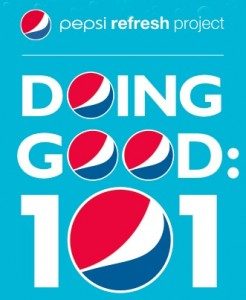 Last year, PepsiCo was famously absent from Super Bowl advertising for the first time in 23 years. Opting, instead, to utilize its $20 million Super Bowl advertising budget to fund the Pepsi Refresh Project.
Last year, PepsiCo was famously absent from Super Bowl advertising for the first time in 23 years. Opting, instead, to utilize its $20 million Super Bowl advertising budget to fund the Pepsi Refresh Project.
Unless you’ve been living under a rock for the past year, you probably already know that every month, the Pepsi Refresh Project awards more than $1.2 million in grants – from $5,000 to $50,000- to bring great ideas to life in communities across the country. So far, Pepsi has distributed more than $20 million dollars to fund hundreds of great ideas.” Online voting enables the public to decide which causes matter most, on a monthly basis. Many people have used Twitter and Facebook to support the campaign including 77 million votes cast via Facebook (nearly 19%).
 Back in October, I attended a Social Media Integration conference in Atlanta, GA. Shiv Singh, Director Digital Engagement & Social Media at PepsiCo was the keynote speaker. This is a man with a deep understanding of the opportunities and complexity of the ever-evolving social media landscape, as well as the ongoing challenge of effective outcome measurement. He, literally, “wrote the book” on social media marketing, this book: Social Media Marketing for Dummies
Back in October, I attended a Social Media Integration conference in Atlanta, GA. Shiv Singh, Director Digital Engagement & Social Media at PepsiCo was the keynote speaker. This is a man with a deep understanding of the opportunities and complexity of the ever-evolving social media landscape, as well as the ongoing challenge of effective outcome measurement. He, literally, “wrote the book” on social media marketing, this book: Social Media Marketing for Dummies
One of the key take-aways from this conference was the importance of utilizing social media platforms and tactics to directly support specific, pre-defined business objectives, as opposed to just jumping on the social media bandwagon “to be there” – the method many companies (large & small) have taken with less than stellar return on investment (ROI).
In yesterday’s article in the New York Times, Pepsi Bets on Local Grants, Not the Super Bowl,
Shiv Singh was clear about the company’s “cause marketing” approach with the Pepsi Refresh Project, saying:
“This was not a corporate philanthropy effort. This was using brand dollars with the belief that when you use these brand dollars to have consumers share ideas to change the world, the consumers will win, the brand will win, and the community will win. That was a big bet. No one has done it on this scale before.” (A nod to American Express’ Members Project which utilizes a similar approach at the $1 million level.)
It seems Mr. Singh has taken his own social media advice. He notes that at PepsiCo, they “look at brand equity, brand health and sales” and that the Pepsi ReFresh Project was designed to support one of those brand pillars, “brand health.” ROI for the project is measured against the specific goal of driving brand health and, secondarily, against additional brand objectives, including brand equity and sales. He indicated that this particular effort is “not a sales-driving program, but viewed as an investment to build brand awareness and cultivate a long-term relationship with consumers.”
My guess is that, like most companies, Pepsi has its eye on the Millennial prize. Investing in appropriate opportunities to engage and motivate this key population of affluent and influential consumers currently coming into their own. Cause marketing and social media can be an elegant point of intersection for savvy marketers that learn to build relationships with Millennials in an authentic and meaningful way. This eMarketer article, Why Causes Might Be the Best Way to Reach Millennials, includes some key survey data that starts to explain why.
 With less than a week before Super Bowl XLV, it’s a sure-thing that some brands, like Bridgestone Tire, will utilize social media to extend their SuperBowl communications. But, the jury is still out on whether or not any brands will utilize this premium advertising moment to support their strategic cause marketing activities or, like PepsiCo last year, opt-out to fund them. We’ll know soon enough—I just hope there aren’t any wardrobe malfunctions to contend with!
With less than a week before Super Bowl XLV, it’s a sure-thing that some brands, like Bridgestone Tire, will utilize social media to extend their SuperBowl communications. But, the jury is still out on whether or not any brands will utilize this premium advertising moment to support their strategic cause marketing activities or, like PepsiCo last year, opt-out to fund them. We’ll know soon enough—I just hope there aren’t any wardrobe malfunctions to contend with!
